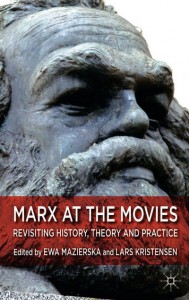Marx at the Movies – Revisiting History, Theory and Practice Edited by Ewa Mazierska and Lars Kristensen (Palgrave Macmillan, 2014), 312 pages, ISBN: 978-1137378606 (hardback) £60
About the reviewer: Dr William Hope is a lecturer in Italian Cinema and Language at the University of Salford. He is the co-ordinator of the AHRC project A New Italian Political Cinema? and his publications include Italian Film Directors in the New Millennium (2010).
 This innovative edited volume draws on the expertise of collaborators from a range of subject areas, its cross-disciplinary momentum channelling Marxist theory and criticism through the prisms of philosophy, fine art, comparative literature, politics and screen media to shed new light on the production, interpretation and reception of films ranging from classics such as Citizen Kane (1941) to the little-known East German children's film Moor and the Ravens of London (1968). Drawing on recent writings by Rancière, Žižek, Badiou and others, Mazierska and Kristensen's introduction offers fresh perspectives on the different manifestations of Communism that have emerged across the world over the past century, and its possible resurrection in an age of imploding capitalism. They also trace the waning and waxing of Marxist theory within academia and as a counter-hegemonic world view, arguing that art imbued with Marxist thought can be potentially instrumental in socio-political transformation, and tracing the relevance of Marxist analysis in contexts such as today's employment sector.
This innovative edited volume draws on the expertise of collaborators from a range of subject areas, its cross-disciplinary momentum channelling Marxist theory and criticism through the prisms of philosophy, fine art, comparative literature, politics and screen media to shed new light on the production, interpretation and reception of films ranging from classics such as Citizen Kane (1941) to the little-known East German children's film Moor and the Ravens of London (1968). Drawing on recent writings by Rancière, Žižek, Badiou and others, Mazierska and Kristensen's introduction offers fresh perspectives on the different manifestations of Communism that have emerged across the world over the past century, and its possible resurrection in an age of imploding capitalism. They also trace the waning and waxing of Marxist theory within academia and as a counter-hegemonic world view, arguing that art imbued with Marxist thought can be potentially instrumental in socio-political transformation, and tracing the relevance of Marxist analysis in contexts such as today's employment sector.
Given the rich diversity of the original Marx at the Movies conference held at UCLAN in 2012, the decision to structure the volume around twelve lengthy essays – rather than include a broader cross-section of shorter pieces – is debatable, but the theoretical rigour and topicality of the approaches is undeniable. Mike Wayne's excellent essay traces the notion of the Dialectical Image from Kant to Marx and Adorno, and its manifestation in commercial genre films such as Romero's Land of the Dead (2005). Johan Siebers' contribution draws on Ernst Bloch and Slavoj Žižek to explore the utopian potential of film elements such as music to evoke as yet unrealized equality and emancipation, while Ian Fraser's technical analysis of Terence Davies' Distant Voices, Still Lives (1988) also identifies micro-level impulses of future utopian solidarity that transcend the patriarchal environments of family and community.
Iris Luppa revisits Fritz Lang's You and Me (1938) to analyse the Brechtian influences set in motion by Lang's camera work, montage and mise-en-scène to depict the alienation of workers within the capitalist system, while Jakob Ladegaard explores different approaches to humour within Marxist film writing, ranging from Adorno's condemnation of mainstream cinema's inducing of collective laughter ('a caricature of solidarity') during the viewing of films, to the use of humour as a form of ideology critique in films such as Godard's Pierrot le fou (1965). Dennis Rothermel analyses the Workerist humour that underpins films such as Huston's The Treasure of the Sierra Madre (1948) and Loach's The Navigators (2001), and Peter Hames' contribution focuses on the recurring phenomenon of alienation in films from the Czechoslovak New Wave of the 1960s. In a fascinating piece of writing, Silke Panse draws on concepts of immaterial labour to explore the rights of documentary protagonists whose images are "taken" by film-makers, their value being appropriated.
... an important contribution towards repoliticising academic writing on film
In his essay, William Brown examines the phenomenon of amateur digital film-making within the structures of capitalism (YouTube, etc.) and the myth that increased access to digital technology devolves power to individuals with access to cameras and websites. John Hutnyk reconsiders Citizen Kane, identifying it as a conduit back to Das Kapital – a cinematic gateway redirecting critical attention towards the topicality of Marx's masterpiece. Ewa Mazierska's essay also focuses on Das Kapital and its cinematic transposition by Alexander Kluge (News From Ideological Antiquity, 2008), the author outlining ways to reconfigure the volume's content artistically and linguistically to increase its resonance for a contemporary public. Appropriately, the volume closes with a piece by Martin Brady that focuses on two East German children's films, Moor and the Ravens of London and Hans Röckle and the Devil (1974) which bring the figure of Marx himself to the screen, the narratives also containing allusions to the contemporary GDR. With a discernible turn away from the postmodern increasingly animating scholarship within the humanities and cinema in particular, Marx at the Movies is an important contribution towards repoliticising academic writing on film, its introduction and essays ably engaging in ideology critique, the denunciation of hegemonies, and reading narratives against the grain to identify the utopian possibilities that have always underpinned Marxist thought.
Dr William Hope